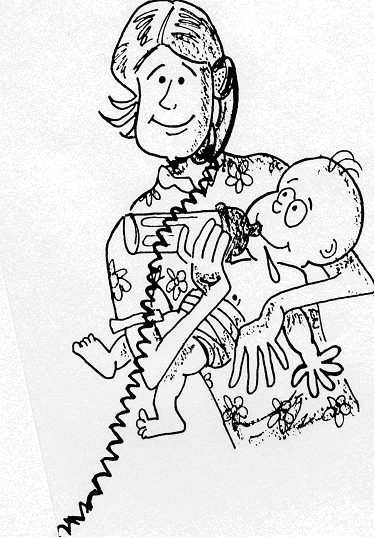
The consumer today is the victim of the manufacturer who launches on him
a regiment of products for which he must make room in his soul.
- Mary McCarthy
Good Suppliers are just as important as good Trade Contractors, and very likely more important. You must have a mutually supportive relationship with your sales representatives: s/he will not only be the person most familiar with installation instructions and warranties but s/he will provide you with a PREFERRED CONTRACTOR LIST for product installation. If you are able to personalize your relationship with your Suppliers, there will be mutual respect and understanding for the products and services required for your project.

WHEN SELECTING A SUPPLIER CONSIDER:
* Is their location near your site?
* Are you dealing directly with a manufacturer?
* Can you limit the number of suppliers with whom you deal?
* Are you able to open a builder account?
* Size of company
* Condition of the supplier's yard and/or shop
* Rate of turnover of sales staff
* Quality of products/materials
* Type of warranty/guarantee
* Will installation instructions be immediately available?
* Determine if you can return unused material
* Cost of products/materials
* Are discounts offered for early payments?
* Itemized billing and Lien Waiver
When purchasing products and materials for your project, you should be ready to compare your "Purchase Order Terms" with terms which may appear on your Supplier's "Invoice." Remind the sales representative of your terms and notice if there are any discrepancies between your requirements and their policies. For instance, most Suppliers insist there be "No returns on Special Orders." Only standard, current stock items are returnable and the usual practice is to require a 20% to 25% restocking fee for stock items. Another example of differences which may occur is the issue of "acceptability" of purchases. There may be slight variations in shade, color, or patterns of products/materials as they appeared in the showroom versus as they appear at delivery. In this case, any question of acceptability as to shade, color, or pattern must be resolved prior to installation. Inquire what may be considered acceptable "variations."

Remember: Avoid conflict by communicating your terms early in negotiations. If you're not sure what terms fit your situation, then discuss your concerns with both Supplier and Trade Contractor, then take your time to weigh and consider the possibilities. You must state your terms on the "Purchase Order" then assert your position at time of purchase.
WHEN PURCHASING MATERIAL:
* Research product choices to fit your situation
* Use Drawings and Specifications to do a material take-off
* Solicit several bid proposals based on Drawings/Specifications
* Follow standard bidding process
* Control purchases with "Purchase Order" forms
* Initiate Orders from your home/office and mail them to Suppliers to authorize Orders
* Coordinate Orders with field to double-check quantities and dimensions
* Place will-call status on Order to allow for changing site conditions
When scheduling delivery of products and materials for your project, be aware that conditions of sale may stipulate the ownership of products/materials, and responsibility for its good keeping, transfer to the customer as soon as it leaves the loading dock of the supplier. This means when this shipment was provided to the Transportation Company, their agent accepted it in good condition. The transportation company agrees to deliver it to you in the same perfect condition. Any claims which you may have must be reported to the Transportation Company immediately to avoid forfeiting claims for damage.
WHEN SCHEDULING MATERIAL DELIVERY:
* Request delivery per field conditions
* Avoid delivery just prior to weekends or holidays
* Provide site address, phone numbers, and directions
* Instructions should stipulate that delivered materials are stacked with the materials to be used first on top
Note: One way to accomplish this is to list those items required on top of the pile at the bottom of the Purchase Order. These items are likely to be loaded on the truck last and therefore end up on top of the load.
* Have materials delivered close to where they will be used
* Include site plan for delivery drivers if they must avoid areas such as septic tanks and leach fields
* Avoid handling materials multiple times
* Minimize site inventory until time of use
Suppliers do not want damaged goods returned to them unless the Supplier previously assumed responsibility for transportation. Whether or not the Supplier provided transportation, be prepared to inspect and check your shipment for concealed damage, visible damage, or missing cartons. Note any problem on copy of Bill of Lading, keep your copy of the Bill of Lading, and immediately contact the Transportation Company and Supplier in writing.
WHEN CONDUCTING MATERIAL INSPECTIONS:
* Inspect material as it arrives on site for correct sizes, quantities, and free from defects or damages. Contact sales representative immediately to report problems.
* Keep materials protected from weather
* Place materials on dunnage
* What can be done to prevent vandalism or theft?
* Create a plan for contending with waste
- Use materials based on modular
- Store excess or end cuts
- Reduce-Reuse-Recycle-Refuse
- Place refuse in dumpster
Note: If this is impractical, sign delivery slip with caveat that final acceptance of material is based on your inspection and ask driver to co-sign that inspection was not made.

When paying for products and materials for your project, you'll want to protect your property from construction liens. Contact a Lawyer in your area to discuss this issue. Two of the more commonly used methods of protection are writing dual checks and obtaining lien waivers. Writing a dual check makes the dollar amount payable jointly to the Trade Contractor providing the labor and the Supplier providing the material. A "Lien Waiver" is a legal document signed and dated by a Trade Contractor or Supplier in the presence of a Notary stating payment has been received for work, services, and material provided for your project. In many states, the lien waiver is the ONLY means to protect yourself from a lien!
WHEN PAYING FOR MATERIAL:
* Match Purchase Orders with Invoices
* Make allowances for damaged or defective materials
* Take advantage of discounts for early payment
* Use float time for billing cycles
* Obtain Lien Waiver AS PAYMENT IS MADE
Your construction project will require products from all over the United States and possibly from all over the world. Consequently, one should create Specifications for their project early in the design process to understand the products required and arrange for Suppliers. Once you have specified products and located Suppliers, there will be a need to formalize procedures for purchase, delivery, inspection, and payment prior to installation. These procedures may seem unnecessary; however, should you receive unwanted, damaged, or late delivery of materials, your project schedule can be delayed for days and often weeks.
Remember: Your relationship with your product supplier is mutually supportive!
| 





